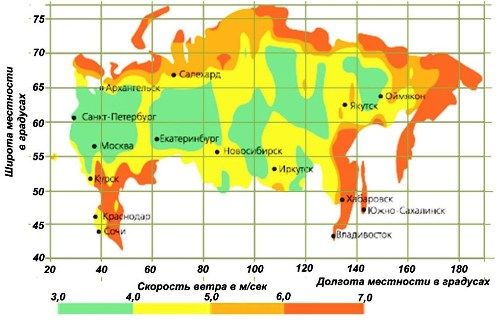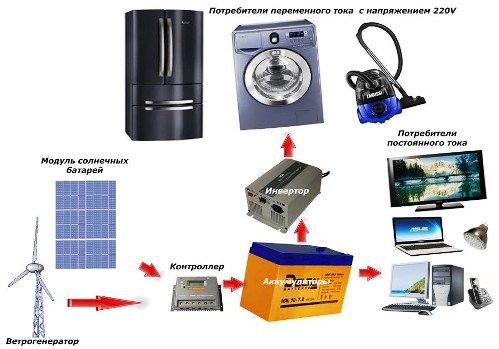Categories: Featured Articles » Autonomous power supply
Number of views: 20109
Comments on the article: 3
Wind generators in Russia: how to choose, install and avoid disappointment
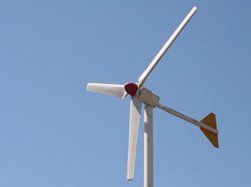 The ability to receive free electricity by the wind appeals to many owners of individual houses, but a certain part of them fails, is disappointed in this method and writes negative reviews in various forums. But you can avoid mistakes in creating such installations and get the most out of them.
The ability to receive free electricity by the wind appeals to many owners of individual houses, but a certain part of them fails, is disappointed in this method and writes negative reviews in various forums. But you can avoid mistakes in creating such installations and get the most out of them.
The wind generator with its electrical circuit and design principles resembles any other electric generator. The main difference lies in the method of spinning its rotor due to the kinetic energy of the air flows captured by the aerodynamic blades.
Estimated local conditions
The speed and power of the wind should reliably rotate the impeller of the engine, the energy of which is consumed by the generator. If this is not done, then you will be left without electricity.
An approximate estimate of the probability of an active wind will be aided by the average annual wind distribution schedule. Just keep in mind that it is designed for a height of 50 meters from the surface of the earth. For real conditions it is necessary to introduce corrections.
The average annual distribution chart of winds for the territory of Russia, defined for heights of 50 meters (for increase, click on the picture):
More specific information for each area can be clarified with the employees of the regional weather station, and take into account the planned installation height. It is not necessary to ask them for wind directions: the wind generator rotates automatically.
Effect of terrain and season
Depending on the season, the wind blows in different ways. In some areas there may be a long lull.
In addition, the wind pressure is sharply reduced:
-
forest and nearby trees;
-
neighboring houses and buildings;
-
the location of the structure in the lowland or behind the elevation.
For the installation of wind electrical installations, hilltops that are open from all directions are best suited. It is advisable to raise the wind turbine to the maximum allowable height. It is better to use a separate strong foundation and a tower with securely attached extensions that increase stability: with powerful wind pressure, huge tipping forces can occur.
Individual owners mount wind power installations on the roof or wall of the house. This is not the best option. It is applicable for low-power engines: the building structure will be constantly shaken by changing dynamic loads, and the noise of a rotating rotor will be transmitted through building elements to residential premises.
Example: on a flat roof of the building of a neighboring department store - a two-story building made of reinforced concrete slabs for two years, a tower with an antenna of the mobile operator MTS worked. After cracks appeared between the panels and the roof began to leak, the antenna was removed, and the building was overhauled.
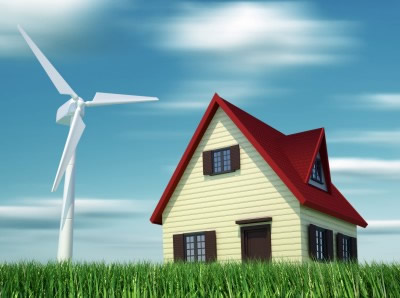
Choosing a wind wheel design
In the entire history of mankind, a huge number of devices powered by wind energy have been tested. Maximum efficiency (high efficiency) is inherent in structures that form a lifting force such as curved blades of aircraft engine propellers (remember the famous expression “From the propeller”) or boat / ship motors located at sharp angles to oncoming air / liquid flows.
To choose a model of a wind wheel, it is necessary not only to know the wind speed (V), but also to determine the design of the fan blades. Their main indicator is the area of the swept surface (S), which is affected by the wind flow.
To estimate the power (N) that the fan can remove, the formula is used: N = (SρV3)/2.
The value ρ is the density of air masses.
Some sellers claim the efficiency of individual wind turbines at air speeds of up to 3 m / s or the size of the blades that describe a circle with a radius of ≤1.3 meters during operation. Substitute the characteristics of their devices in the above formula: you check the reliability of such advertising statements according to the elementary laws of physics.
Wind with a speed of ≤3m⁄sec cannot reliably transmit energy to a conventional wind generator. But for such conditions, you can use the blades of increased area, which is created by increasing their dimensions - especially the length of 2 meters. However, such structures, due to the four-meter span, are more suitable for industrial plants.
If we return to the schedule of distribution of winds and take into account their specific effect on the wind wheel (not at a height of 50 meters), then if the nature of the winds matches the orange zone (from 5 m / s) or higher, the Voronezh State University will justify the costs of its production and installation.
At high wind speeds, the generated power increases sharply. In such cases, just any wind generator is configured. In other situations, he may not live up to his expectations.
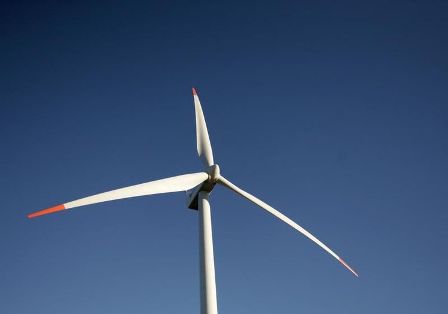
Introduction to manufacturer specifications
Testing and checking the power of the wind generator is carried out in the factory: a wind tunnel with an adjustable air flow from stationary fans. This checks the aerodynamic characteristics of aircraft and all car bodies. But this method does not reflect the actual operating conditions of a wind electric installation.
In a wind tunnel, the wind blows in one direction with constant effort, but in reality it always changes somewhat both in speed and direction. Observe the behavior of a regular weather vane. And the wind generator from it is very different from the effects of acceleration and braking.
To understand this, it is enough to try to unwind a hand with a simple bearing (weather vane blades), and then the rotor of an electric generator (or motor) stuffed with windings surrounded by electromagnetic fields. The created opposition will have to be overcome even at idle. When connecting the load (for the sake of this, everything is done), it is required to apply more power.
Change in wind pressure
Slight gusts of wind (stronger / weaker) have little effect on the rotor speed, and wind shocks - significantly. To counter them, various damping schemes are used, including braking and folding of structural elements.
An example is wind generators with a high keel position (tail end). During a storm impact, the entire structure is abruptly tilted back to a rather large weight.
After reducing the pressure, it returns to its place. In one gust of wind, the towers of the tower double the energy of the storm. And if such a wind generator is fixed on the building, then it perceives such shocks. Just how?
The electromagnetic braking system works better and softer, which closes the windings at critical speeds. But it is much more complicated and expensive.
Wind direction change
Wind can create gusts from different sides in a horizontal plane. Many designs of wind generators react very sensitively to such loads due to the large area of the swept surface of the working blades.
Wind generators begin to repeat the movement of the wind load, but, having a significant mass, the axis of wind direction passes by inertia and goes to much larger deflection angles.
With significant gusts of wind, it can reach a perpendicular direction or slip through it and stop in the opposite state to the wind. The wind wheel will stop, return to its original position and exit to operating mode. In these situations, the vibration damping system (if any) does not function well.
The weather vane is also not immediately installed in the direction, but its mass is much less, and the efforts spent on electromagnetic processes are not applied.
Lightning protection
For some reason, they forget about it or remember it last. But in vain. The location of metal structures at high altitude, and even generating electricity during a thunderstorm, creates the prerequisites for attracting lightning potentials.
It is simpler to think over the design of lightning protection and create it together with the installation of a wind generator than later to do the modifications.
Typical home station wind circuitry
It is necessary to determine the final design of the wind generator taking into account the tasks of electric energy consumption. The load connection diagram should help.
A simplified diagram of a home power plant with a solar battery and a wind generator (click on the picture to enlarge):
It is necessary to start selecting a wind generator according to the generated power on the principles described in the article “Solar power plants for the home”. Read this article and you will understand that wind and solar stations operate on the same algorithms.
Please note that such stations can fit perfectly into the overall scheme and complement each other, work in conjunction on the same power equipment: inverter, controller and batteries can work from any source: solar panels, wind.
Under certain conditions, it is economically feasible. Although you can abandon the solar battery and work only from a wind generator. The choice is yours.
Some sources recommend the use of a wind generator without a controller and batteries to power the heating elements that heat the water of boilers, or incandescent bulbs. There is a ripe grain in this idea: the scheme is greatly simplified. But nichrome filaments in the cold state have low active resistance, which simply shunts the output terminals of the generator. This point should be taken into account at each start of such a circuit: turn on the preheating device.
Possible problems
When operating a wind generator, you may experience:
-
violation of the strength of the foundation fastening or mechanical stretch marks. They should be inspected periodically;
-
icing of the body and blades in cold weather leads to the appearance of additional weight, which creates increased loads and reduces the efficiency of the system;
-
deterioration in stability due to a violation of the rotational speed (changing wind speed), which is most typical for asynchronous generators;
-
fire in the electrical circuit with insulation damage.
The best global manufacturers of wind generators
The equipment of these companies has reliably proven itself, therefore it has a high cost. However, at the initial stage of the development of wind energy, you can try to make a similar design with your own hands. The skills gained from its implementation will help assess the potential for wind loads in your area without large financial costs.
See also at bgv.electricianexp.com
:

